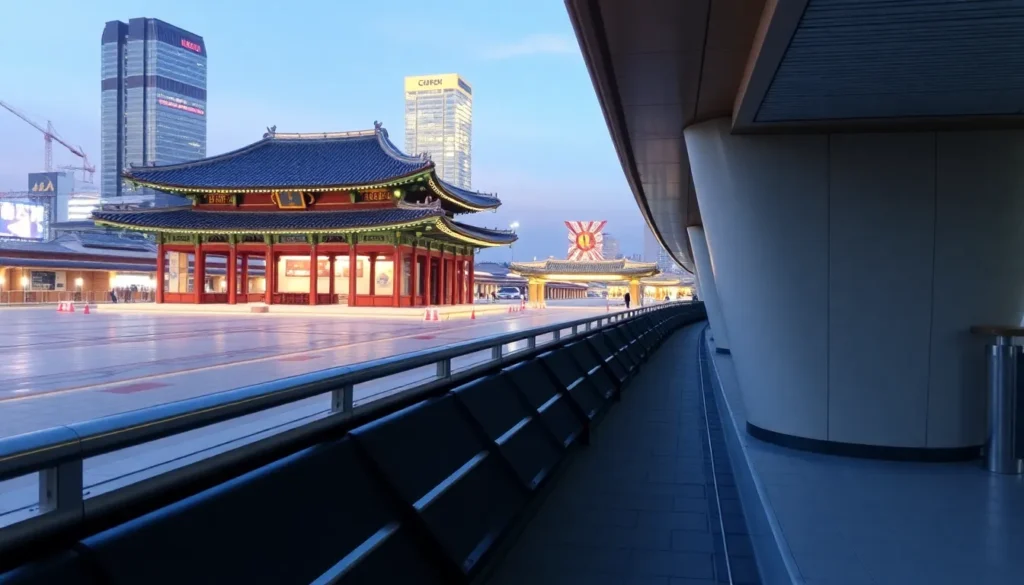How to Get from Seoul Airport to City Center

Every journey begins with that crucial first step: the transfer from the airport to your accommodation. Knowing how to navigate this transition is vital for kicking off your adventure on the right note, especially in a country like South Korea, where the language barrier can be daunting. This guide will detail how to get to the center of Seoul from the airport, presenting all available options, costs, pros and cons, and our personal recommendations to ensure a smooth arrival.
⭐ Check out our top tips for visiting Seoul
First things first, you should be aware that Seoul is served by two main airports:
- Incheon International Airport (ICN)
- Gimpo International Airport (GMP)
During your travels in South Korea, it's likely that you will end up using both airports, so we will thoroughly explain how to reach the city from each of them. Even if you already have a preferred mode of transport in mind after reading, it’s beneficial to download the Kakao Map and Naver Map apps, which provide instant transport solutions from point A to B (Google Maps is somewhat limited in calculating routes in Korea).
Note: If you have a long layover at Incheon Airport, you are entitled to various benefits included in the "K-Stopover" program.
How to get from Incheon Airport to Seoul
Located approximately 50 kilometers west of Seoul, Incheon Airport is the main gateway to the city and one of the busiest airports in Asia. With two terminals, both equipped with train and bus stations, getting to the city is straightforward.
Opened in 2001, Incheon has gained recognition as one of the world's best airports due to its cleanliness, organization, and extensive services, including a golf course, spa, casino, museum, recreational center, and beautiful gardens. It’s practically an attraction in itself.
However, if you're eager to begin your Korean adventure, here’s how to make your way to the city:
Bus Services
Incheon Airport offers various bus routes to multiple destinations in Seoul. For example:
- Lines 6001 and 6015 go to Myeong-dong (which we recommend)
- Line 6701 passes through Myeong-dong and reaches Gwanghwamun
- Line 6009 arrives at Insa-dong
- Line 6002 stops at Hongik Univ. Station in the lively Hongdae area
- Line 6702 serves the Namsan and Dongdaemun areas
- Lines 6009, 6020, and 6703 head towards Gangnam
More routes are available! The fare for these buses is approximately 17,000₩, which can be purchased at vending machines located in Terminal 1 at exits 4 and 9, or at ticket counters both inside and outside the terminals. In Terminal 2, tickets can be obtained directly at the Transit Center (B1).
These buses operate throughout the day (approximately from 05:30 to 22:30), with frequent departures. If you arrive late at night, there are night lines, although with more limited destinations. Travel time varies based on your destination and traffic conditions, typically taking between 60 to 75 minutes.
Tip: On the airport website, you can use a route finder to input your destination area and view the buses that service that route, including their schedules and departure points. Ensure you spell the name correctly (e.g., Myeong-dong can yield different results with or without a hyphen). You can also use Kakao Map, Naver Map, or Google Maps to help determine the most convenient bus for your needs.
Backpacker Tip: If you plan to use K-Limousine lines (6701, 6702, 6703, and 6705), consider purchasing your ticket online with a discount through this link. You'll receive a QR code to scan when boarding the bus.
Make sure to carry a Revolut card and/or a N26 card to avoid hefty foreign transaction fees.
Train Services
There are two different trains connecting Incheon Airport with the Seoul Station, both operated by the Airport Railroad (AREX):
- The Express Train which makes no intermediate stops, making it the fastest option but slightly more expensive. It takes between 43 and 51 minutes, depending on the terminal you board from, costing 9,500₩.
- The All Stop Train stops at 14 stations along the way, making it a slower yet more affordable option. This train journey lasts between 59 and 66 minutes, with the full fare costing around 5,000₩.
Both trains depart from the two terminals, and to board them, follow the signs to the “Airport Railroad” to reach the Transit Center, where you will find two separate accesses: one for the express (marked in orange) and another for the all-stop train (marked in blue).
When you arrive, you can purchase tickets at ticket counters or vending machines, or use a T-Money card, which can be used on this train. If you prefer, you can buy it online at a discount from this link and collect your ticket using a QR code at the machines (it's quite simple).
Where to buy the T-Money card? You can purchase it at convenience stores within the airport (popular ones include CU, 7Eleven, and GS25) or at vending machines in the transport area. The card costs 3,000₩ (non-refundable), while themed cards with designs will cost slightly more. To use it, you'll first need to recharge the card at designated machines.
Operations run from 05:15 to 23:30, with the Express service running every 40 minutes and the All Stop service every 10 minutes.
It's possible that you'll need to complete your journey by taking the metro from either Seoul Station or another intermediate stop. The metro fare starts at 1,250₩.
Taxi and Private Transfer Options
There is no fixed rate for taxis between the airport and central Seoul, as the fare will depend on the taxi meter. Expect to pay around 40,000-50,000₩, depending on your drop-off location and traffic conditions. The toll fee will be the passenger's responsibility (around 8,000₩), and if you travel during the night, the fare increases by 20%.
There’s a special type of taxi called International Taxis designed specifically for foreigners, where drivers are required to speak English. Naturally, these taxis are pricier than standard ones.
Regarding ride-hailing apps, Uber does not operate in South Korea, but there is a local version called Kakao Taxi, which requires registration. While it can be useful for pinpointing your destination on a map, it may not be cheaper than traditional taxis. Be aware that the fare shown in the app is merely an estimate based on the taxi meter.
If you'd prefer to avoid any possible miscommunication when explaining your final destination, you can always pre-book a private transfer. This service is slightly more expensive, but drivers often have a basic understanding of English and will meet you at the arrivals hall at the airport. You can reserve this service at this link.
What We Did
We stayed in Myeong-dong for our first accommodation, and since we weren't familiar with the metro system, we opted for a direct bus to Myeong-dong Station (lines 6001 and 6015). To return to the airport at the end of our trip, we left from Gangnam and took Line 9 of the express metro to Gimpo Airport, then transferred to the Airport Railroad’s “All Stops” train. Overall, this journey cost us around 5,000₩, which we paid using our T-Money card.
If your accommodation is also in Gangnam, you might find the limousine bus (lines 6009 and 6020) convenient, as it stops along Gangnam-daero for a fare of 17,000₩.
How to get from Gimpo Airport to Seoul
Gimpo is Seoul's older airport, originally built by Japanese forces during World War II. Today, it primarily handles domestic flights, although it also accommodates some international flights. It features two terminals: domestic and international, and is situated closer to the city center, around 15 kilometers west. Here are your options for reaching Seoul:
Bus Services
Given its location, you can catch several lines from the Seoul urban bus system, such as line 601 to Gwanghwamun or line 605, which ends at Seoul Station. These buses operate from early morning (around 04:00 or 05:00 AM) until midnight, with fares costing about 1,500₩.
You also have the option of taking a more comfortable and faster limousine bus. The CALT company offers two lines from Gimpo Airport: 6101, which arrives at Suraksan Station making stops through central Seoul, and 6105. Operating hours are from 07:30 to 22:30, with departures approximately every 30 minutes. The fare is around 9,000₩.
Metro Services
Fortunately, this airport is serviced by two metro lines heading to central Seoul. The Line 5 (purple) runs from west to east across the city, while Line 9 (yellow) heads towards Gangnam. Be cautious, as Line 9 has express services that skip certain stops, meaning if you're heading to one of the non-priority stations, you may need to disembark at an intermediate station and switch to the all-stop train.
The metro operates from 5:30 AM to nearly midnight, with travel time averaging around one hour. A single fare costs about 1,500₩, depending on your final destination.
Train Services
You can also utilize the All Stop Train from Airport Railroad (AREX), which connects Gimpo Airport to Incheon Airport and Seoul Station. It takes about 25 minutes and costs 1,450₩.
Taxi and Private Transfer Options
Taking a taxi is the most convenient but also the most expensive way to travel from Gimpo Airport to central Seoul. There are various types of taxis, including standard, deluxe, and International Taxis. The fare will depend on the taxi meter, traffic conditions, and the type of taxi you choose, typically ranging from 20,000 to 30,000₩ for the basic option. As mentioned earlier, Kakao Taxi is an alternative ride-hailing service to consider.
Lastly, you can book a welcome transfer service at the airport. This option is particularly appealing to overcome any potential language barriers, as drivers usually speak some English and are accustomed to handling tourist transfers. You can reserve this service at this link, but keep in mind that it will be slightly pricier.
What We Did
We flew into Gimpo Airport from Jeju Island, and our accommodation was in Gangnam. Fortunately, Line 9 passed very close to our hotel, so that was our choice.
Be cautious as this line has express trains (which don’t stop at every station) and all-stop trains. If your stop isn’t one of the priority stations, we recommend taking the express train to the last stop before yours and then waiting for the all-stop train.
We hope this detailed guide has clarified how to get to Seoul from both Incheon and Gimpo Airports. Which transport option will you choose?
Keep up with our daily adventures in South Korea through our Instagram stories.
| Save on your trip |
| Compare and find cheap flights here |
| Find accommodation at the best prices here |
| Book activities and excursions in Spanish here |
| Get a 5% discount on your travel insurance with IATI here |
| Book your airport transfers here |
| Find out how to withdraw cash without fees here |
| Rent a car with the best deals here |
| The best travel books and guides here |
| All our articles about South Korea |






Deja una respuesta